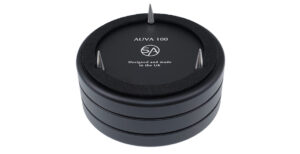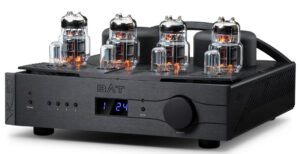
To say the classic BBC LS3/5A is ‘iconic’ is something of an understatement. Even though the design is older than many of the people who buy a pair today, despite the BBC having long since moved on to other loudspeakers for speech monitoring in small spaces, and the age of the design notwithstanding, the LS3/5A still pulls in the kind of cult following that few other products can match.
As such, the LS3/5A’s specification sheet is functionally sacrosanct. Which means that Rogers making an ‘SE’ version could be the stuff of pitchforks and burning torches (OK, angry posts on internet forums and Twitter feeds… but that is merely the 21st Century version of the angry mob). In fairness, Rogers is one of the few brands that could make a souped-up LS3/5A, as most of those original era BBC-designed loudspeakers sold in the domestic market had a Rogers badge. But that brand equity would be eaten up fast if the SE version of the LS3/5A was more an ‘homage’ to the speaker than the speaker itself.
Rogers already makes standard 15-ohm versions of the LS3/5A, using new versions of the 19mm Mylar dome tweeter and 110mm Bextrene mid-bass cone originally made by KEF. Everything about those standard Rogers LS3/5A is as per the original LS3/5A; an outstanding mini-monitor of its time that still sets a high bar in terms of transparency, especially in the mid-range. However, if we are being truly honest about the LS3/5A, its dynamic range is somewhat ‘muted’ in its standard guise. In an effort to not be burned at the stake for my heretical stance, that is set against modern loudspeaker designs, many of which trade tonality and accuracy for excitability, and that’s one of the big reasons why the LS3/5A deserves its cult status.

The whole SE version project actually started out as trying to find a way to make the LS3/5A more dynamic without changing the speaker itself. Rogers experimented with the loudspeaker stand and found Panzerholtz (a.k.a. ‘Tankwood’) to be a perfect, if costly, partner. Panzerholtz is a mix of hardwood and phenolic resin, prized both for its acoustic properties and the fact it’s literally bulletproof! It ends up being about the densest material this side of making the stand of solid metal, but without the hysteresis issues or the problem of making a stand into a kind of 24” tuning fork you can get with solid metal stands. It wasn’t too much of a step from there to seeing what impact Panzerholtz would make when replacing one or more of the thin walls of the LS3/5A’s cabinet. Listening tests followed fast.
To maximise benefit without ending up with a loudspeaker that costs significantly more than the base model, only the front baffle of the LS3/5A SE is made from Panzerholtz. This also facilitated an investigation into what benefits the last half century of electronic engineering might have on the crossover network, and the R1 and R2 resistors in the crossover are of a higher grade (but the same values) than the BBC circuit specifies. Such is Rogers commitment to the LS3/5A, however, that everything else remains identical to the specifications laid down more than half a century ago. And if you want absolutely identical to the original – right down to recreating something close to the original Gold Badge of mid-70s Rogers speakers – you can get that too.
The SE invites a bit of a musical conundrum though. The Keepers of the Flame will likely reject the SE version without ever listening to it. Those who want a LS3/5A because they have heard it can sound good will –hands down – prefer the SE in a straight comparison. It does everything the LS3/5A does, but with a little more pep in its step. Dynamic range is wider, soundstaging is deeper and more open, the sound is lither and music flows effortlessly, and the overall sound has a bit more of a rhythm to it. Those who think the piano tone of a LS3/5A is sweeter than the real thing will find the SE is more like an actual piano. And yet, all of these changes do not undermine the basic LS3/5A presentation; speech is still world-class, and that more accurate piano sound just sounds more like it gave up artificial sweeteners.
One of the big changes sonically is in terms of soundstage size and the ability for the loudspeaker to ‘disappear’ in the room. Typically, the smaller a loudspeaker gets, the closer it gets to a point source, making for superior soundstage properties. The LS3/5A has long had that advantage so it’s soundstaging was never less than ‘excellent’, but the SE version makes that soundstage both wider and deeper, and present a more focused ball of sound between and in front of the loudspeakers. This is most telling in the trail off from ‘I Capuleti e i Montecchi’, Act 2: “Tu sola, o mia Giulietta… Deh! tu, bell’anima” from the Stella Di Napoli album by Joyce DiDonato, [Erato]. Gradually the orchestra fades to just her voice and a beautiful bit of French horn playing, and the two ‘instruments’ sit perfectly in a three-dimensional space that just makes the sound that bit more enticing.
Perhaps just as importantly, the SE version makes the LS3/5A start and stop faster. Often typical LS3/5A music programming doesn’t really challenge a loudspeaker’s transient delivery, as a lot of speech and classical music is quite legato in reality. So for this test, it’s best to really push the Rogers loudspeaker to the edge of its comfort zone… ‘Becoming Insane’ from Infected Mushroom’s Vicious Delicious album [World Club Music]. When the fast back-beat kicks in, the speed and precision of the SE responds accordingly. Original LS3/5A models tend to be slightly behind the beat, but because that Panzerholtz front baffle is so inert, the pace of the sound is markedly improved.

The SE doesn’t radically change the LS3/5A. It doesn’t add octaves to the bass, doesn’t make a low-sensitivity design with relatively limited amplifier headroom suddenly become a party loudspeaker… but if it changed these things, it wouldn’t be an LS3/5A, and I’m both aware and conscious that this name game is sailing close to philosophical noodling. The point is, just that relatively simple change to a Panzerholtz front baffle makes the LS3/5A SE a better loudspeaker without undermining what makes the LS3/5A a great speaker to begin with. While that will fall on deaf ears to some, I suspect many will feel this the right balance between ‘preservation’ and ‘performance’.
Finally, there are two parts to this story. The Panzerholtz stands designed for the SE are expensive but are a worthwhile upgrade to any existing LS3/5A. Compared to a pair of old but trusty Kudos S50 stands that have regularly been pressed into service to support BBC loudspeakers, the improvement is astonishing, in a ‘Playtex’ kind of way (it lifts and separates the sound). Vocals – which are the original reason for the LS3/5A’s existence in the first place – are better projected into the room and are even more articulate. Listening to BBC (of course) Radio Four newsreaders and continuity announcers is an acid test of a loudspeaker because they are perhaps the best annunciators around and if you listen regularly, a known source. Even the mildest deviation from fidelity comes through as too much chestiness, slight emphasis on sibilants or even a mild ‘spitchiness’ to the midrange, and the loudspeaker stand ensures those elements are dealt with thoroughly. I think the stand is a mandatory ‘must include’ for LS3/5A owners, whether or not that loudspeaker has a SE suffix. It might also be a ‘must have’ for owners of post-LS3/5A designs like the Spendor Classic 4/5 or the Harbeth P3 ESR, but I didn’t have a pair of either to test.
The Rogers LS3/5A SE maintains the BBC legacy while adding to it just enough to make the speaker that bit more exciting sounding, yet not so much as to undermine what makes the speaker so beloved. Meanwhile the stand will make a group that often dismisses such things sit up and take notice. And the combination of the two makes a LS3/5A sound that I always wanted to hear, but never quite worked out in the real-world.
TECHNICAL SPECIFICATIONS
Type: Two-way infinite baffle stand-mount loudspeaker
- Frequency response: 80Hz–20KHz +/-3dB
- Nominal Impedance: 15 Ohms
- Bass/midrange: 110mm Bextrene cone
- Tweeter: 19mm Mylar dome
- Crossover frequency: 3KHz
- Sensitivity: 82.5dB/W/M
- Recommended amplifier range:
30-80 Watts - Finish: Amazaque (other finishes on request)
- Grille: Black Tygan
- Dimensions (H×W×D): 305 × 190 × 165mm
- Weight: 4.9Kg (per speaker)
- Price: £3,499 per pair
Type: dedicated loudspeaker stands
- Base plate: 210mm (W) × 290mm (D)
- Top plate: 190mm (W) × 160mm (D)
- Height: including base and top plate 610mm excluding spikes
- Weight: 4.3 Kg each, excluding spikes
- Construction: Panzerholz wood
- Finish/: Black
- Price: £1,499 per pair
Manufactured by: Rogers International UK Ltd
Tel: +44(0)333 533 0135
URL: rogers-hifi.uk
By Alan Sircom
More articles from this authorRead Next From Review
See all
Stack Audio AUVA 100
- May 16, 2024

Xavian Virtuosa Anniversario
- May 16, 2024

REL Classic 98
- May 07, 2024

Balanced Audio Technology VK80i
- May 07, 2024










